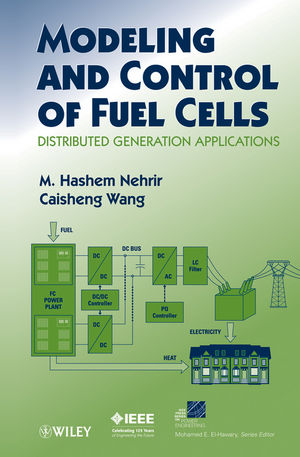Modeling and Control of Fuel Cells: Distributed Generation ApplicationsISBN: 978-0-470-23328-3
Hardcover
312 pages
March 2009, Wiley-IEEE Press
 This is a Print-on-Demand title. It will be printed specifically to fill your order. Please allow an additional 10-15 days delivery time. The book is not returnable.
|
||||||
Acknowledgments.
1 Introduction.
1.1 Background: A Brief History of U.S. Electric Utility Formation and Restructuring.
1.2 Power Deregulation and Distributed Generation.
1.3 DG Types.
1.4 Fuel Cell DG.
1.5 The Hydrogen Economy.
2 Principles of Operation of Fuel Cells.
2.1 Introduction.
2.2 Chemical and Thermal Energy of an Element.
2.3 Fundamentals of Thermodynamics.
2.4 Fundamentals of Electrochemical Processes.
2.5 Energy Balance in Chemical Reactions.
2.6 The Nernst Equation.
2.7 Fuel Cell Basics.
2.8 Types of Fuel Cells.
2.9 Fuel Cell Equivalent Circuit.
2.10 Capacitance of Double-Layer Charge Effect.
2.11 Summary.
3 Dynamic Modeling and Simulation of PEM Fuel Cells.
3.1 Introduction: Need for Fuel Cell Dynamic Models.
3.2 Nomenclature (PEMFC).
3.3 PEMFC Dynamic Model Development.
3.4 PEMFC Model Structure.
3.5 Equivalent Electrical Circuit Model of PEMFC.
3.6 PEMFC Model Validation.
4 Dynamic Modeling and Simulation of Solid Oxide Fuel Cells.
4.1 Introduction.
4.2 Nomenclature (SOFC).
4.3 SOFC Dynamic Model Development.
4.4 SOFC Dynamic Model Structure.
4.5 SOFC Model Response—Constant Fuel Flow Operation.
4.6 SOFC Model Response—Constant Fuel Utilization Operation.
5 Principles of Operation and Modeling of Electrolyzers.
5.1 Principle of Operation of Electrolyzers.
5.2 Dynamic Modeling of Electrolyzers.
5.3 Electrolyzer Model Implementation.
6 Power Electronic Interfacing Circuits for Fuel Cell Applications.
6.1 Introduction.
6.2 Overview of Basic Power Electronic Switches.
6.3 ac/dc Rectifiers.
6.4 dc to dc Converters.
6.5 Three-Phase dc/ac Inverters.
7 Control of Grid-Connected Fuel Cell Power Generation Systems.
7.1 Introduction.
7.2 Grid-Connected System Configuration.
7.3 Controller Designs for dc/dc Converters and the Inverter.
7.4 Simulation Results.
7.5 Summary.
8 Control of Stand-Alone Fuel Cell Power Generation Systems.
8.1 Introduction.
8.2 System Description and Control Strategy.
8.3 Load Transient Mitigation Control.
8.4 Simulation Results.
8.5 Summary.
9 Hybrid Fuel Cell Based Energy System Case Studies.
9.1 Introduction.
9.2 Hybrid Electronically Interfaced Systems.
9.3 Fuel Cells in Hybrid Combined Heat and Power Operation Mode.
9.4 Case Study I: A Hybrid Stand-Alone Wind–PV–FC System.
9.5 Case Study II: SOFC Efficiency Evaluation in Hybrid Operation Mode.
9.6 Summary.
10 Present Challenges and Future of Fuel Cells.
10.1 Introduction.
10.2 Fuel Cell System Operations.
10.3 Present Challenges and Opportunities.
10.4 U.S. Fuel Cell R&D Programs.
10.5 Future of Fuel Cells: A Summary and Authors Opinions.
References.
Appendix A Instruction for Running the PEMFC and SOFC Models and Their Distributed Generation Application Models.
Index.



